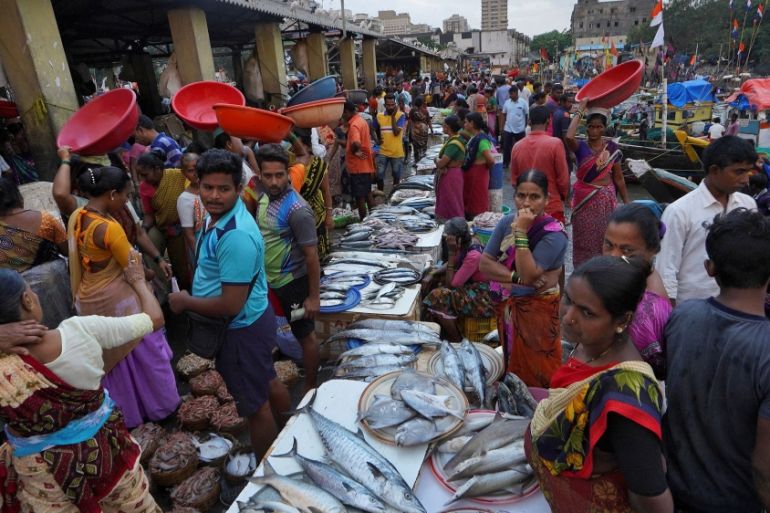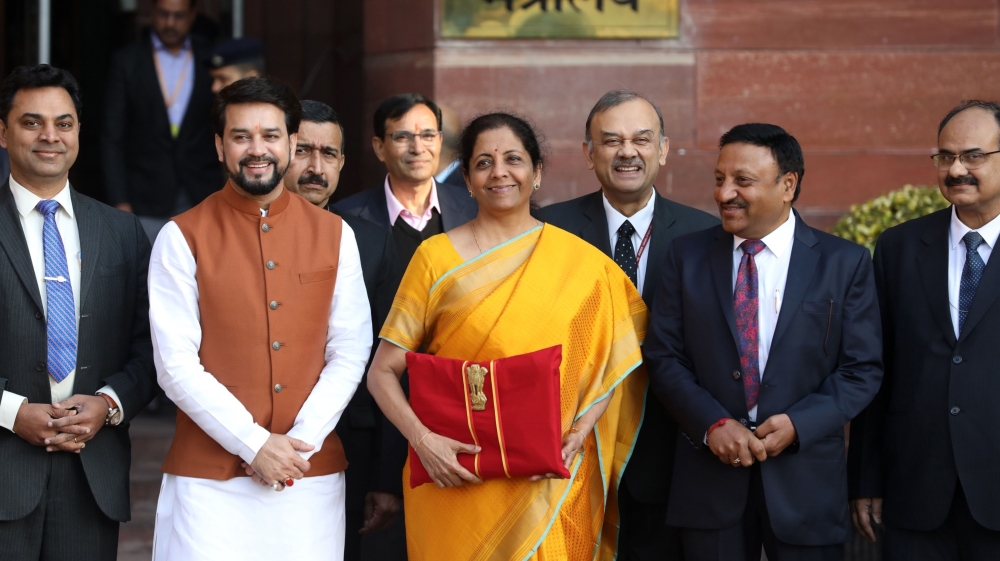India’s 2020 budget: Will it be enough to kick-start the economy?
With growth at a six-year low, finance minister’s first budget of decade fell short of widely expected reforms.

Mumbai, India – Waiting outside a popular lunch spot in Mumbai after a Sunday morning game of cricket, textile exporter Rishi Patel has more on his mind than the performance of his team.
“The wholesale market is just flooded right now with Chinese products, while consumption is down at home,” Patel, 22, who runs his family’s business, told Al Jazeera in the Matunga neighbourhood of India‘s financial capital. “We’ve been laying off some people over the past year.”
Keep reading
list of 4 itemsIndia-Iran port deal: A gateway to Central Asia or a geostrategic headache?
India’s income inequality widens, should wealth be redistributed?
Facebook, Instagram face EU scrutiny over addictive effects on children
The problems that Patel faces are also plaguing much of India’s economy, issues that Finance Minister Nirmala Sitharaman tried to address in her annual Budget speech on February 1. But many analysts say the government’s proposals are unlikely to help people like Patel or many others.
India’s economy has been hurt by events beyond its control: The trade war between the United States and China, and steadily climbing imported energy costs being two of them.
But government policies have also played a part in reducing India’s economic growth rate to its slowest in 11 years, resulting in an uncompetitive domestic manufacturing sector, a shrinking job market and consumers tightening their purse strings, leaving many businesses in despair.
“Employment and therefore the economy can only go up if the government helps small and medium enterprises like ours,” says Patel. “We were expecting more action.”
Hands tied?
While Sitharaman did introduce tariffs on “cheap and low quality” imports like footwear and furniture in a protectionist move to help businesses like Patel’s, many in his position wish the government had used the budget to lay out a more concrete plan to tackle the slowdown in India, which was until just a few years ago, the world’s fastest-growing large economy.
Analysts acknowledge that, in some ways, the government’s hands are tied.
According to the International Monetary Fund, the Indian government’s debts amounted to 68.5 percent of gross domestic product (GDP), the most commonly used yardstick of the size of an economy. That is far higher than the average for emerging and developing economies of 55.7 percent of GDP.
In its latest Economic Survey for its 2019-20 fiscal year, presented in Parliament a day before the budget, the government said it spent more than it received in revenues by a margin of 3.8 percent of the size of India’s economy, the so-called fiscal deficit. That figure missed the government’s own target of restricting overspending to 3.3 percent of gross domestic product (GDP).
Many analysts believe the government needs to spend aggressively to stimulate growth, even if it means widening the fiscal deficit. Those who were looking for big-ticket spending plans in Sitharaman’s budget were disappointed.

The IMF agrees that growth needs a boost. In a recent assessment of India, it said economic development projects will be vital in the coming years.
“But to generate the revenue needed to get them off the ground, India’s debt – among the highest in emerging markets – must be reduced,” it said. “Despite some improvement in reported fiscal deficits, debt as a share of GDP remains little changed over the past decade partly due to increases in off-budget financing.”
In what was one of the longest ever budget speeches, the slowdown was not mentioned once, but the government’s goal to become a $5 trillion economy in the next five years remained in place.
Critics argue that while the budget was mildly expansionary, it was mostly filled with populist handouts.
“The budget has provided little steer in any direction and so it is now up to luck,” Maitreesh Ghatak, an economics professor at the London School of Economics told Al Jazeera.
“One can hope for good weather providing some relief on the agricultural front or some positive tailwinds from the global economy – however even for that, the budget’s direction towards an inward-looking import substitution policy does not augur well,” Ghatak added.
Little effect on consumption
To boost consumption, Sitharaman announced $5.6bn worth of annual income tax cuts for India’s middle classes.
“This is the Budget to boost their incomes and enhance their purchasing power”, she said.
But analysts say the system’s recent redesign, which asks taxpayers to choose between two methods of taxation, is unnecessarily complicated and may cancel out any gains.
“The basic idea of this budget should have been to put more money in the hands of people and encourage them to consume,” Vivek Kaul, an economist and author of the Easy Money trilogy told Al Jazeera, “But instead, it has left the income tax payer confused on a basic question: Has my income gone up?” It is likely that many taxpayers are better off staying with the current system, he added.
India’s rural population, whose incomes have remained stagnant while food prices have surged – rising as much as 14 percent last year – saw minor relief in the form of increased spending on rural roads and housing programmes, as well as investments in food storage and transport infrastructure. But the Budget also took away fertilizer, food and petroleum subsidies.
The government says it remains committed to doubling farm incomes by 2022. Such moves are also in line with the policy recommendations in its Economic Survey. The report suggests targeting subsidies towards a smaller segment of society, but comes at a time of significant rural distress.
Avani Kapur, director at Accountability Initiative, Centre for Policy Research, a research think-tank, explains the decision by pointing out that “gross tax revenue receipts were three trillion rupees ($42bn) lower this year than projected in the budget estimate”. She adds that the government has already had to dip into “extra-budgetary resources like the National Small Savings Fund (NSSF) to meet the food subsidy requirements”.
Another disappointment for those looking for help for some of India’s poorest communities was a cut to a rural jobs programme. India’s unemployment rate remains near a three-year high at 7.2 percent according to the Centre for Monitoring the Indian Economy.

The Mahatma Gandhi Rural Employment Guarantee Scheme saw a $1.3bn funding cut although welfare schemes “should be raised or at least maintained when slowing demand from the masses is a leading cause behind the economic slowdown,” says Ghatak.
The government proposed a boost in investment for its National Skills Development Agency, an initiative to improve youth employability to help tackle the unemployment problem.
But “several people have flagged serious concerns with the limited nature of the skilling programmes,” Amit Basole, head of the Centre for Sustainable Employment at Azim Premji University told Al Jazeera.
Basole did welcome a new proposal for engineering graduates to intern with urban local bodies. “This resembles a part of our proposal for an urban job guarantee scheme that we made last year,” he added, “but falls well short of what is needed.”
The government believes its $1 trillion investment in infrastructure could also be a “huge employment opportunity”.
No ‘trickle-down’ benefits
Another source of concern for investors and consumers has been India’s ailing non-banking financial sector – companies such as insurers and mortgage issuers – and government-controlled banks.
Many observers had expected the budget to make special provisions to boost the sector’s productivity and spur lending, especially with memories of a 2018 debt default by Infrastructure Leasing & Financial Services, a large so-called shadow lender, still fresh in people’s minds.
Instead, the budget was “notably silent on relief measures,” Saurabh Mukherjea, founder and chief investment officer of Marcellus Investment Management, told Al Jazeera. He urges the government to work with the Reserve Bank of India, the country’s central bank, to protect investors who buy debt issued by such non-bank lenders.
Though the government has tried to address the lack of liquidity with a $10bn bank recapitalisation programme, investor confidence remains low and credit lines restricted. Patel, the textile exporter, says businesses like his are not receiving the “trickle-down benefits” of such actions even after the central bank cut lending rates to commercial banks.
The introduction of a national goods and services tax (GST) in mid-2017 which was supposed to simplify the country’s tax policy, but instead left companies reeling under mountains of paperwork and delayed payments, has also dented company cash flows.
“We have no capital to play with,” says Patel. “The banks are still reluctant to lend and because of GST, we are often left waiting for up to a year for money to come back to us.”